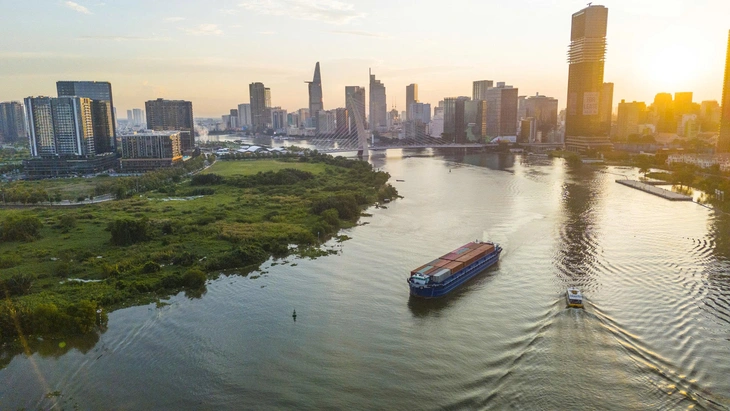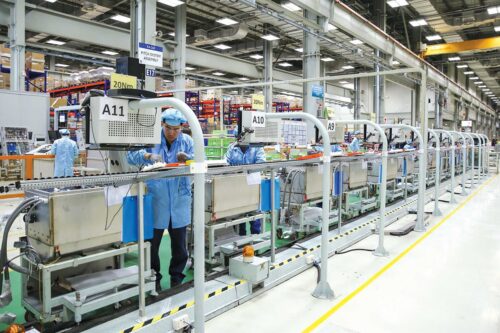By Mr. Dinh Hong Ky – Published on Tuoi Tre Online, September 3, 2025.
In the context of climate change and the global trend toward sustainable development, the megacity of Ho Chi Minh City not only possesses vast space and abundant development resources but also faces an urgent demand for green transformation.

The administrative merger offers the new Ho Chi Minh City greater spatial and resource capacity to pursue a synchronized green transition—from the urban core of HCMC to the industrial hubs of Binh Duong and the coastal zones of Ba Ria–Vung Tau. However, this also entails greater responsibility for emission reduction.
Without Transition, the Megacity Cannot Sustain Its Leading Role
Ho Chi Minh City (in its current form) is already the largest emitter of greenhouse gases in Vietnam, and emissions are projected to rise further as it integrates Binh Duong (urban–industrial) and Ba Ria–Vung Tau (energy). Therefore, a green growth strategy must be placed at the center of the new metropolitan development model.
The new Ho Chi Minh City should promptly establish a comprehensive policy framework for green growth to achieve net-zero emissions by 2050, aligning with Vietnam’s COP26 commitments. According to research by HIDS, if the city fails to accelerate its green transition, it will struggle to maintain its role as the nation’s economic locomotive, especially as global supply chains increasingly regard ESG compliance as a “mandatory passport.”
The city has developed a green transition roadmap focusing on six key pillars:
-
Energy
-
Transportation, construction, infrastructure, and logistics
-
Industry
-
Green urban infrastructure
-
Trade and services
-
Agriculture and food
This comprehensive framework needs to be translated into actionable plans with measurable targets. For instance, setting goals for the share of renewable energy in industry by 2030, or quantifying CO₂ reductions in transportation.
Resolution 98 has granted Ho Chi Minh City several special mechanisms to accelerate green growth. The city should leverage these to immediately enact its 2024–2030 Green Growth Action Plan, prioritizing breakthroughs in renewable energy, green logistics, green finance, and the circular economy.
The expanded metropolitan area now enjoys new advantages: broader land availability, improved interregional infrastructure, and especially a rich marine ecosystem (spanning Can Gio and Ba Ria–Vung Tau) that can foster distinct green economic sectors.
Overcoming the Green Energy Bottleneck
Ba Ria–Vung Tau is emerging as one of the country’s new energy centers, with numerous offshore wind, solar, and LNG power projects under development. The new Ho Chi Minh City should provide maximum support to expedite these projects—from permitting to grid integration.
Once multi-gigawatt offshore wind farms in Ba Ria–Vung Tau become operational, they could supply stable green electricity to industrial zones, reducing reliance on coal-fired power. Meanwhile, Binh Duong, home to thousands of factories, offers vast potential for rooftop solar deployment. The local government should encourage every factory and shopping complex to install solar panels—reducing power costs while adding clean capacity.
A current bottleneck lies in the restrictive Direct Power Purchase Agreement (DPPA) mechanism. Ho Chi Minh City could propose that the Ministry of Industry and Trade expand the DPPA framework across the region, allowing industrial parks in Binh Duong and Dong Nai to directly purchase wind or solar power from projects in Ba Ria–Vung Tau.
This would help domestic enterprises access renewable energy as easily as foreign-invested firms (FDIs), enabling them to meet green standards required by export partners. Additionally, the city should innovate in green infrastructure development—for example, by exploring floating solar farms on major reservoirs (such as Dau Tieng and Tri An) to expand renewable generation without consuming land, or by piloting nearshore wind turbines in Vung Tau and Can Gio in combination with eco-tourism initiatives.
In transportation, priority should be given to clean mobility. Ho Chi Minh City has begun with VinBus electric bus routes and Metro Line 1—important early steps toward green public transport. The city should aim for 100% of urban buses to use electric or CNG power by 2030, and establish a regional network of public EV charging stations. Expanding pedestrian and cycling infrastructure will also reduce emissions and enhance urban livability.
Promoting Circular Industry and Pollution Control
 Chị Đoàn Trần Hoàng My sử dụng máy BOTOL đặt tại cửa hàng Annam Gourmet để tái chế các chai nhựa – Ảnh: QUANG ĐỊNH
Chị Đoàn Trần Hoàng My sử dụng máy BOTOL đặt tại cửa hàng Annam Gourmet để tái chế các chai nhựa – Ảnh: QUANG ĐỊNHBinh Duong and Ho Chi Minh City together host hundreds of manufacturing facilities, making the adoption of a circular economy model in industry indispensable. This means treating waste and by-products as valuable resources for reuse instead of disposal.
Ho Chi Minh City has already initiated measures such as waste segregation at source, developing waste-to-energy plants, and planning to establish an EV battery recycling center, positioning itself as a crucial link in the global recycling supply chain.
These initiatives must be accelerated and expanded across the region. Industrial parks in Binh Duong could pilot eco-industrial zones based on the principle of industrial symbiosis—where one factory’s waste becomes another’s raw material.
Private Sector Leadership Is Key
The green transition cannot rely solely on limited public funds. The private sector must be mobilized in both investment and innovation. The city should tap into international green finance sources, as many global investment funds and development agencies offer concessional loans for green projects—though domestic administrative procedures remain cumbersome.
Hence, establishing a Green Investment Promotion Board is recommended, serving as a focal point to engage institutions such as ADB, JICA Green Fund, and the EU Green Deal, and attract financing for electric bus networks, community renewable projects, and wastewater treatment.
Moreover, a Ho Chi Minh City Regional Green Trust Fund could be created to pool capital from both public and private sources, offering low-interest loans to SMEs pursuing green initiatives.
Private enterprises should be recognized as the vanguard of the green transformation. While the government can facilitate, it is businesses that must view environmental compliance as an opportunity to innovate and elevate brand value.
In reality, although 80% of Vietnamese businesses are aware of sustainable development, there remains a significant gap between awareness and action—largely due to cost barriers, limited expertise, and consumer affordability.
Therefore, state leadership in market transformation is essential—through policies such as green public procurement (prioritizing eco-friendly goods in public spending) and higher taxes or fees on polluting products. As domestic demand shifts toward green consumption, businesses will be compelled to transform or risk losing market share.
Green Growth as a Key to Competitiveness
When green growth becomes the key driver for Ho Chi Minh City to achieve its 10% GDP growth target in 2025 and a benchmark of competitiveness, we can expect the new Ho Chi Minh City not only to sustain its role as Vietnam’s economic locomotive but also to emerge as a national leader in sustainable development.
Lessons from Global Green Transitions
Many cities worldwide have demonstrated that green transformation not only protects the environment but also enhances economic competitiveness.
For instance, Copenhagen (Denmark) aims to become the world’s first carbon-neutral city by 2025—a goal that has spurred the development of green industries exporting wind energy and water-treatment technologies globally.
Singapore, though small in size, has likewise committed to net-zero emissions by 2050 and is heavily investing in electric vehicle infrastructure, urban greening, and positioning itself as the regional green finance hub.


